Feature: Concrete equipment
30 April 2021
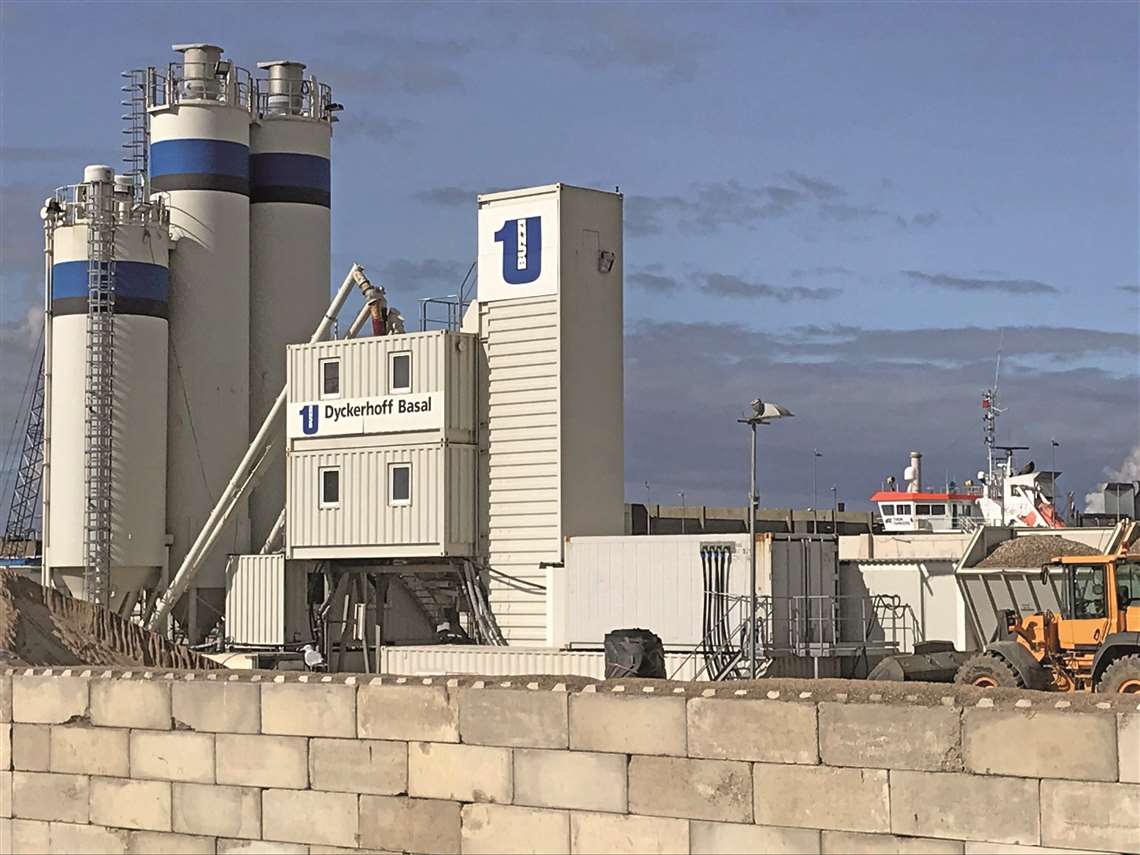 A Liebherr Mobilmix 3.5 produces the concrete for the largest lock in the world
A Liebherr Mobilmix 3.5 produces the concrete for the largest lock in the world
Amid an erratic climate that can seem to be changing by the day, the construction industry can only thrive if materials continue to withstand the test of time, elements and humanity. The impact of the global pandemic has meant that a stable demand is no longer guaranteed; nearly every industry in the world has been touched by the effects of coronavirus, and the world of concrete is no exception. However, as the construction industry begins to see improvements, so does concrete.
“We are lucky because the concrete industry is related to the construction industry – the construction industry is still going well,” said Klaus Eckert, head of marketing, Liebherr-Mischtechnik GmbH.
Rapid International, a UK-based manufacturer of equipment for the concrete, construction and environmental industries, agrees with this sentiment, as the company has been largely unaffected by Covid-19. “Lead times for orders have increased due to increased demand, supply chain delays and reduced labour as a result of the first government lockdown,” said Kelly McCollum from Rapid International.
“We’re privileged to have an onsite design team and a comprehensive 50,000 square foot production facility, which includes a shot blasting and paint booth. We’re also fortunate that our sister company, Rapid Power Generation, manufactures diesel powered generators onsite, which powers our range of mobile plant. As such, virtually none of the production process is outsourced, offering us a higher degree of control.”
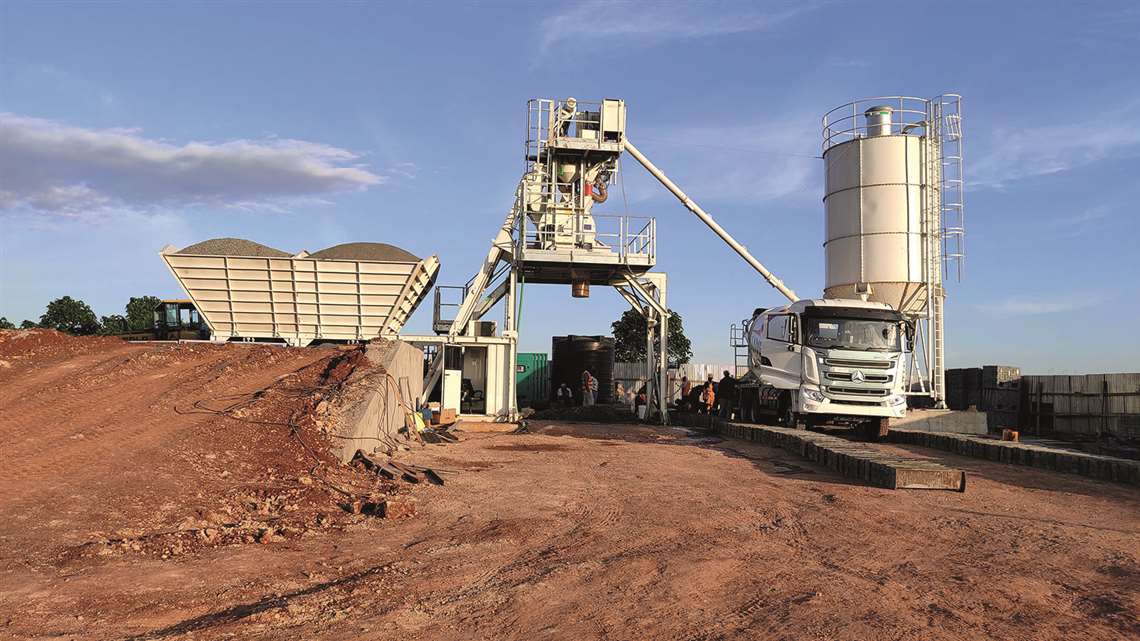 Nairobi-based Jilk recently purchased an Ammann CBT 60 SL Elba Concrete-Mixing Plant
Nairobi-based Jilk recently purchased an Ammann CBT 60 SL Elba Concrete-Mixing Plant
Ammann is a supplier of mixing plants, machines and services to the construction industry with expertise in road building and transportation infrastructure. Many companies in a range of industries were forced to adapt to a new way of life following the pandemic, and Ammann was no exception. The company says they were able to capitalise on the intensive use of online meetings via Skype, Zoom, and other platforms to stay connected with customers and suppliers.
New concrete technology
Concrete projects are being implemented with higher levels of accuracy than ever before, thanks to new technology. This was the case with the modernisation of the D1 freeway between the Czech Republic’s two largest cities. Two slipform pavers and a texture curing machine from Wirtgen rehabilitated a 67km stretch of freeway in the direction of Prague. During the process, the paving train paved two layers in one pass and widened the two lanes at the same time.
For this project more than 60,000 tons of concrete were used over a period of 20 days. Contractor Eurovia CS used the new paving train from Wirtgen to pave the road surfaces with exposed aggregate concrete in optimal quality. Wirtgen used two SP 154(i) slipform pavers as bottom layer and top layer concrete pavers and a TCM 180(i) texture curing machine.
The SP 154(i) is equipped with four steerable and slewing crawler units. This allows the machine to be controlled with maximum flexibility in different job site conditions and the steerable and slewing crawler units are said to make the pavers easy to load.
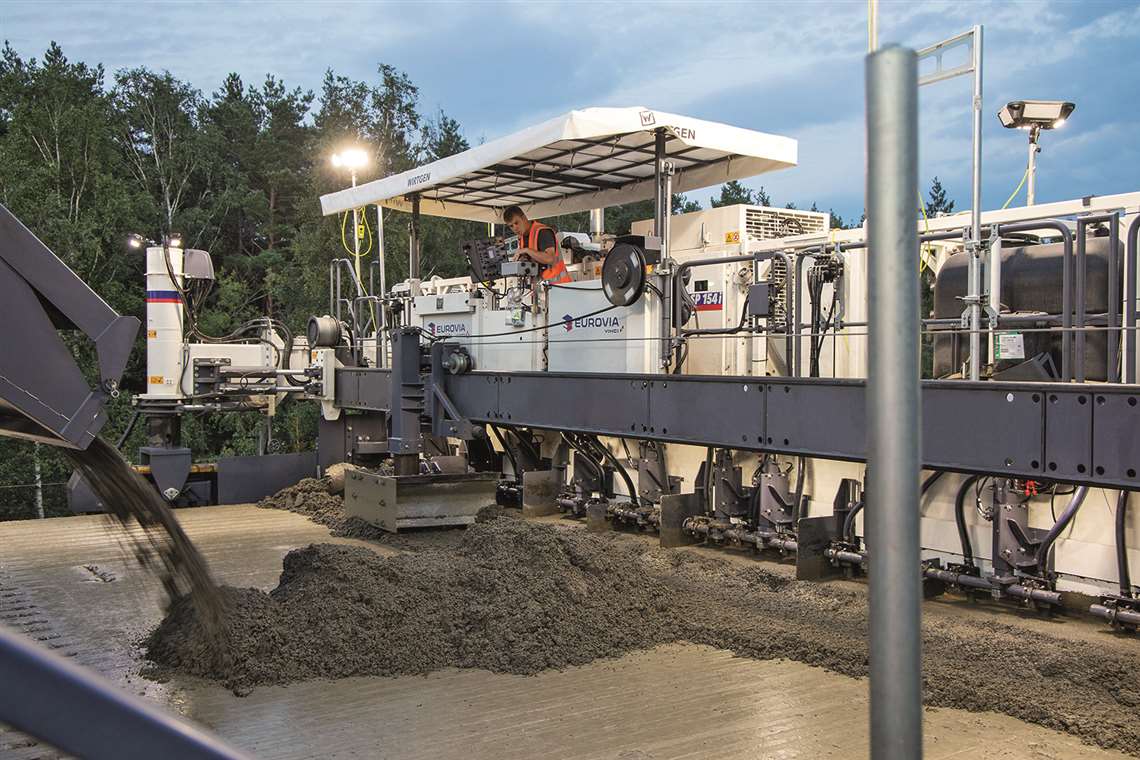 According to Wirtgen, the two-layer paving method was chosen for the project as it allows a less expensive mix to be used for the road bed
According to Wirtgen, the two-layer paving method was chosen for the project as it allows a less expensive mix to be used for the road bed
The two-layer paving method is cost-effective because only the top layer consists of relatively expensive exposed aggregate concrete. In contrast, a less expensive mix can be used for the roadbed. Paving the top concrete layer ‘wet on wet’ produced an excellent bond between the layers on the 11.5m wide and 27cm high road surfaces. Together, the 22cm thick bottom layer concrete and the 5cm thick top layer concrete produce a road surface with an extremely high bearing capacity.
“We are thoroughly impressed with Wirtgen’s new SP 154(i) slipform paver,” said Roman Pistek, concrete road construction technology specialist, Eurovia CS. “The resulting surface quality is absolutely remarkable.”
Sometimes for a project to proceed it is necessary for concrete to be removed, as was the case in the Philippines on a substantial bridge system connecting Cebu City with Cordova on the southern end of Mactan Island. The 8.5km Cebu-Cordova Link Expressway, slated for completion in 2021, will span the Mactan Channel with 51m navigational clearance for shipping vessels.
When a bad batch of concrete threatened to derail progress on one of the bridge’s first pilons, project managers needed a creative solution that could quickly remove the poor-quality concrete without damaging the rebar or putting the project behind schedule.
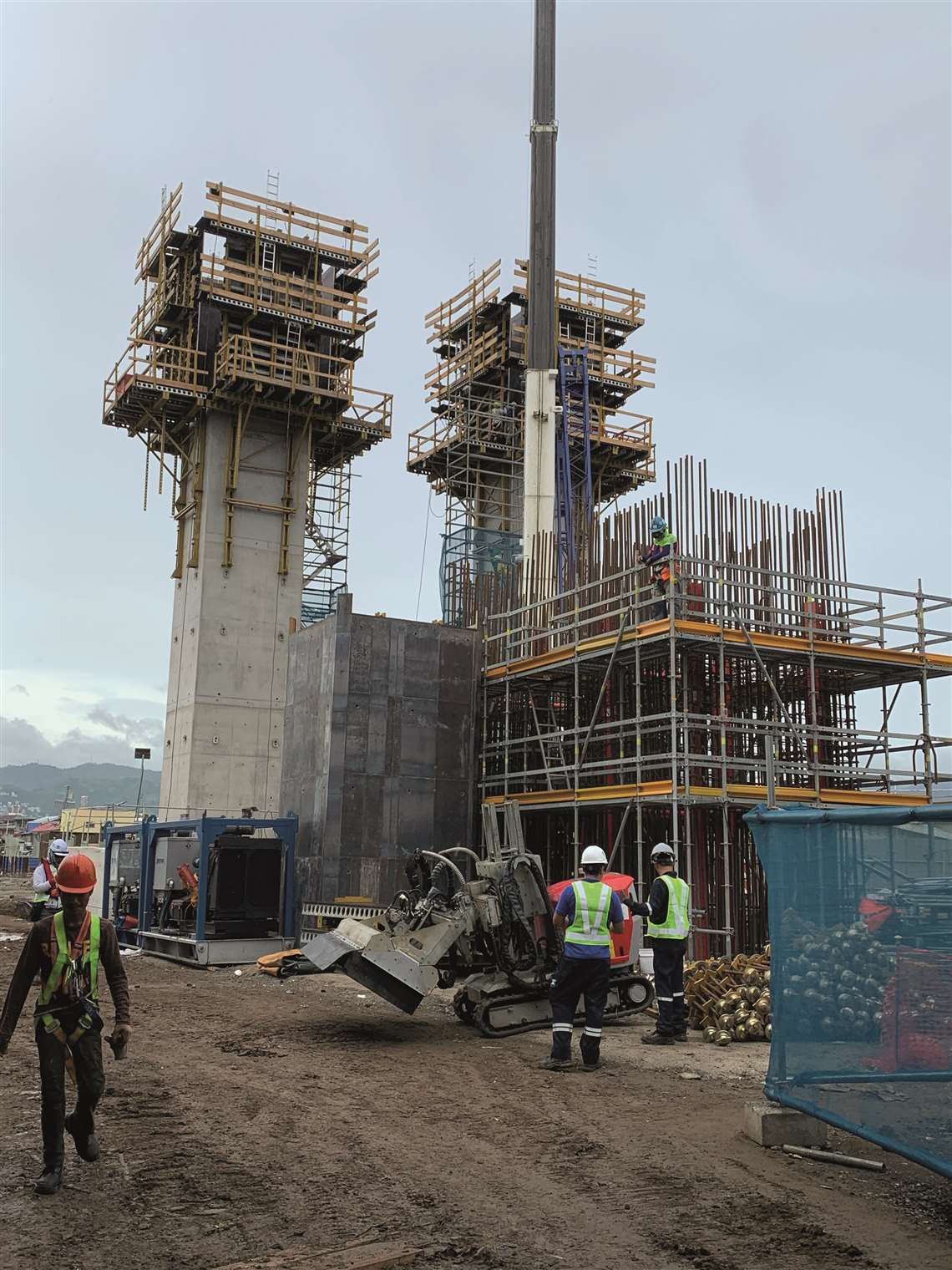 A bad batch of concrete threatened to derail progress on one of the Philippines’ largest infrastructure projects
A bad batch of concrete threatened to derail progress on one of the Philippines’ largest infrastructure projects
Cebu Link Joint Venture (CLJV) contacted Singapore-based Asia Waterjet Equipment, the region’s premier hydrodemolition experts. Access and site conditions presented a challenge. With the clock ticking and monsoon season in full swing, the team arrived onsite with an Aquajet Aqua Cutter 710V Hydrodemolition robot and Jetstream HP Waterjetting Pump.
Hydrodemolition was the only solution. The non-intrusive method uses high-pressure water jets as powerful as 40,000 psi manipulated by an automated robot to remove layers of deteriorated and damaged concrete. The high-pressure water exceeds the strength of the concrete to widen existing pores and microcracks, breaking it apart in a controlled manner.
“With the Aquajet Aqua Cutter, we increased productivity to a point where construction was back on schedule,” said Chris Parkhill, Asia Waterjet Equipment Sales Director for Southeast Asia. “Without Hydrodemolition, there’s no way CLJV would have been able to do that.”
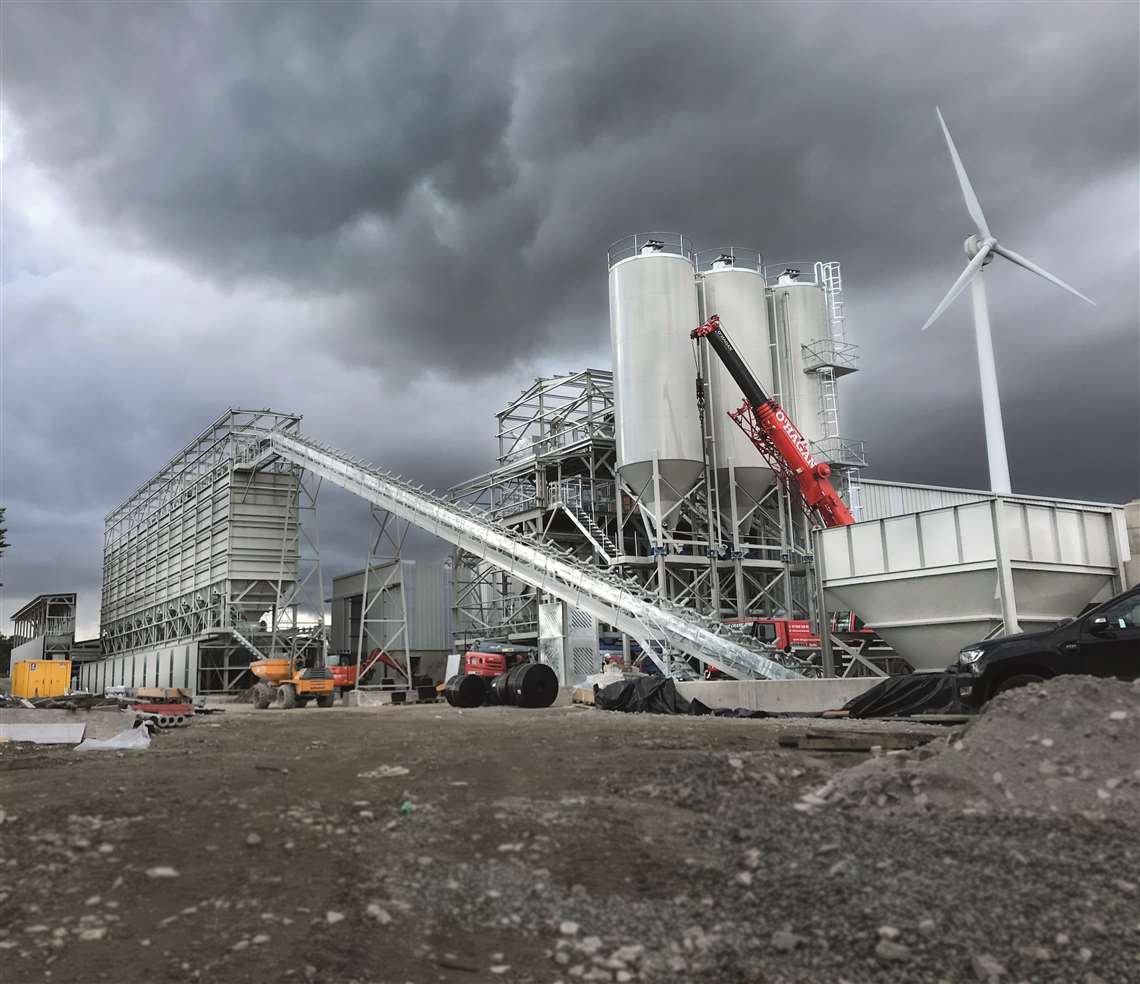 As part of its recent US$13 million expansion Tobermore has invested in a bespoke state-of-the-art Rapid concrete batching plant
As part of its recent US$13 million expansion Tobermore has invested in a bespoke state-of-the-art Rapid concrete batching plant
Market predictions for concrete equipment
With the worst of Covid-19 hopefully behind us, market demand is on the rise as infrastructure projects and developments resume.
“Concrete will continue to play an important role in the future, as there is a trend from ready-mix concrete to more precast concrete,” said Liebherr’s Eckert.
Ammann cites a growing demand for improved and innovative developments, as the concrete industry continues to advance and ultimately flourish.
“In our opinion, the development of modern concretes is not finished yet,” said Volker Kies, director of sales, concrete plants, Ammann. “This presented challenges to the mixing and control technology. Mechanical adjustments, optionally available accessories for our mixing systems, as well as capacity and expansion for the storage of aggregates and the further development of the control systems are requirements for ensuring the production of modern concretes and concrete products.”
Outside the UK, the US is Rapid’s largest market, with projects heavily weighted towards infrastructure – something that is set to increase.
“The future looks bright for concrete with the announcement of President Biden’s US$2 trillion infrastructure plan,” commented McCollum.
“We believe that we’ll see an increase in demand for our Rapidmix mobile continuous mixing plant by large civil engineering contractors, particularly for large scale highways, bridges and tunnel projects.”
As the concrete industry once again finds its footing and continues to evolve, one huge component is moving forward with sustainability and ‘green’ efforts. This is, quite simply, one of the largest trends in the concrete industry.
Ammann says there are two points to be emphasised regarding current sustainability efforts. “The first is the energy consumption to produce concrete and the second is the conservation of aggregates resources,” said Kies. “In order to limit the energy expenditure there are more and more frequency converters for large drives to avoid current peaks when switching on.
“The optimisation of the mixing systems allows the production of modern concretes with the same mixing time and thus saves energy and material wearing. The use of recycled aggregates helps to protect the environment when manufacturing concrete and supports the material cycle.”
“Later, in 2010 we installed a wind turbine, which produces enough energy to power our entire production facility,” said Rapid’s McCollum.Rapid International’s ‘green’ journey first began in 1992, with the development of the Rapid Reclaimer, a reclaiming unit for the recovery of unused concrete.
“Our innovative Trakmix, track-mounted mobile continuous mixing plant, which launched in 2015, enables civil engineering and geo-technical companies to undertake remote location projects with ease and meet the growing demand for eco-friendly projects.”
Cement savings
 Mobile plants – such as this Ammann one in Thailand – are increasingly popular
Mobile plants – such as this Ammann one in Thailand – are increasingly popular
In an effort to reduce carbon emissions, Liebherr offers high weighing accuracy in concrete batching plants, which ultimately results in cement savings. “Electric truck mixers also run cleanly as Liebherr offers new concepts that are suitable for everyday use,” concluded Eckert.
The growing demand for eco-friendly projects has directly impacted the way companies in the concrete industry tackle new work. For example, Keltbray, a specialist engineering business, has teamed up with Wagners and Capital Concrete, in saving 240 tons of carbon by installing permanent works piles using Earth Friendly Concrete at its Canada Water Project. The project, on behalf of client British Land, comes as part of Keltbray’s ongoing commitment to carbon reduction across its portfolio.
British Land has committed to transforming its portfolio to net zero carbon by 2030, the company said. In the coming decade, it has plans to accelerate the reduction of embodied carbon in its developments, which is forecast to be around half its annual carbon footprint. In the future it may be that environmentally-friendly concrete projects become increasingly common as the industry plays its part in cutting carbon emissions.
STAY CONNECTED



Receive the information you need when you need it through our world-leading magazines, newsletters and daily briefings.
CONNECT WITH THE TEAM









